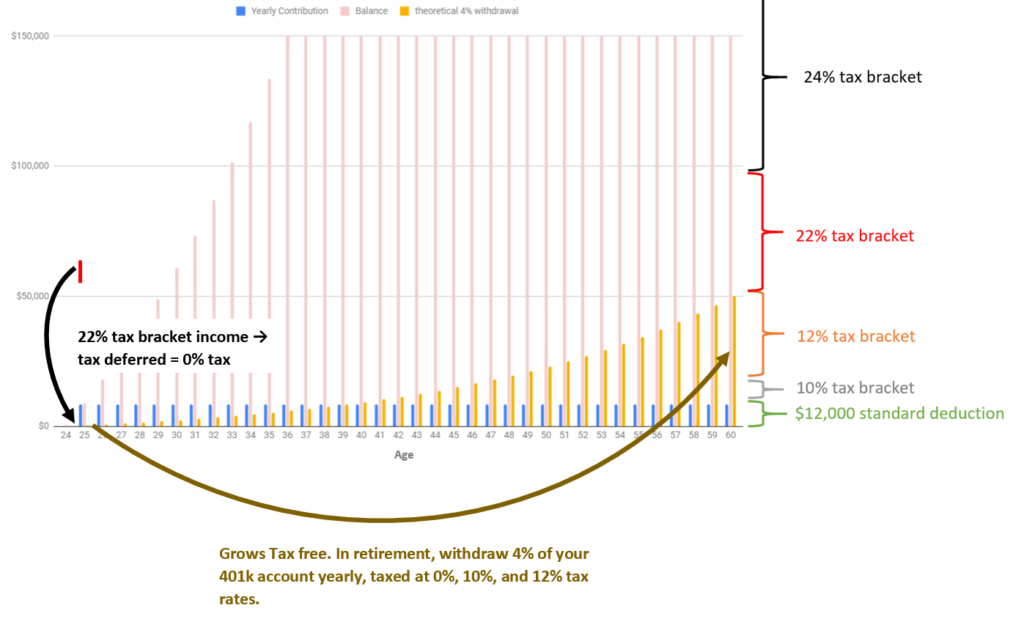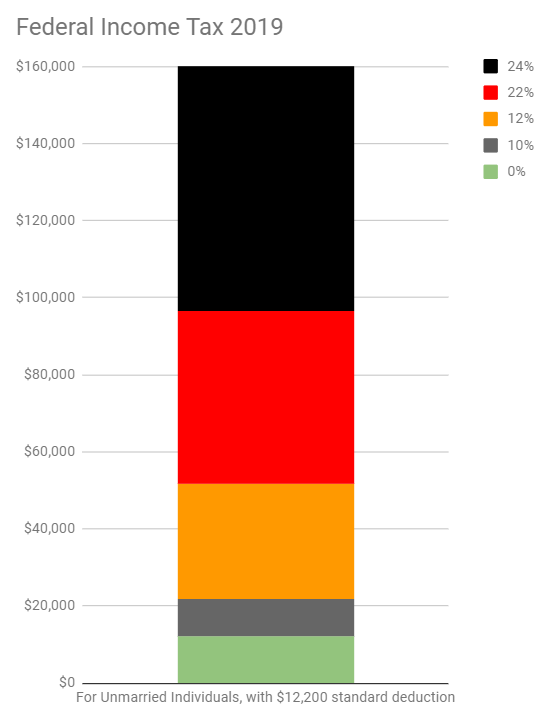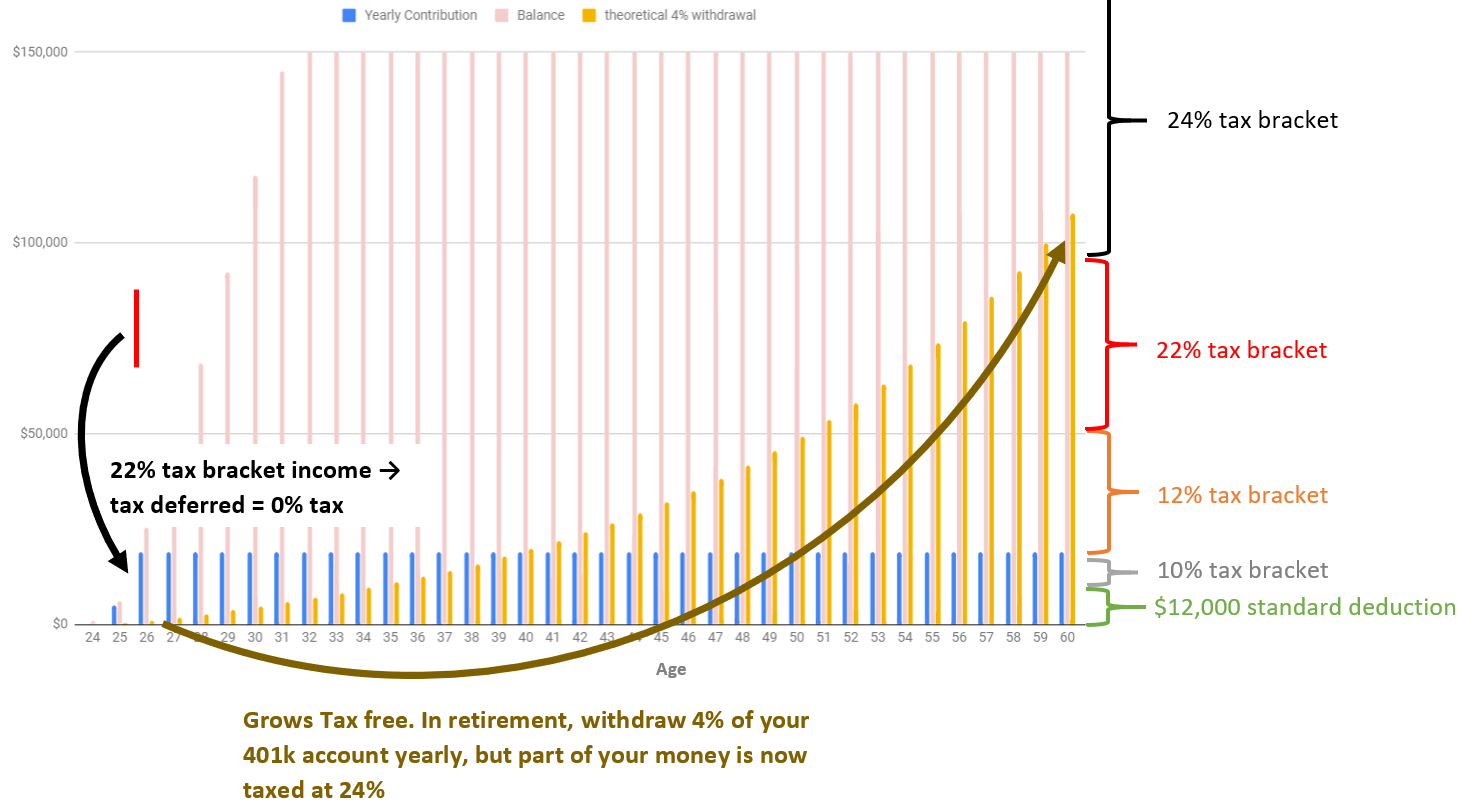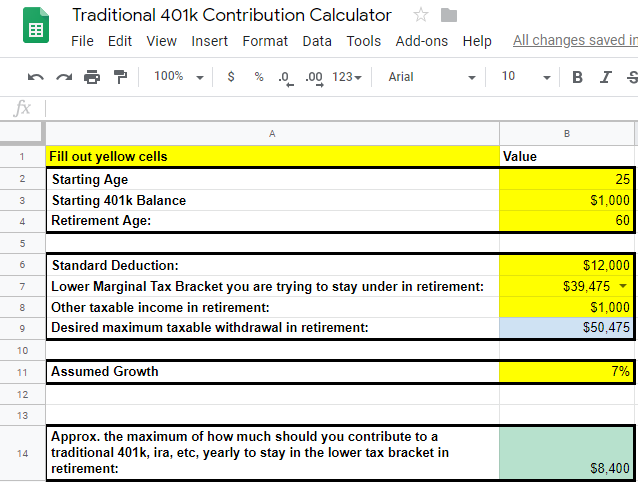So you’ve decided to contribute to your company 401k retirement account (great!). Your company offers both a traditional 401k and a Roth. Now you need to decide if you should contribute to Roth or traditional, or what combination of the two.I’ll be using a Roth 401k and a traditional 401k in my comparisons in this article, though an IRA, 403b , or 457 plans with traditional and Roth options have the same tax concepts and can be compared similarly.
There is a link to a Google spreadsheet calculator at the bottom you can copy to use!

How Traditional 401k Taxes Work
With a traditional 401k, the contributions are tax deferred. This means you don’t pay taxes now, but pay at a later time. Given that you withdraw after age 59.5 years old, you would pay normal income taxes on the full amount you withdraw. Any gains or dividends accrued before withdrawal stays tax deferred until withdrawal. There are penalties for withdrawing early, and also some methods to avoid such penalties, but I will assume you have your bases covered and will not be withdrawing until 59.5 years old.
How Roth 401k Taxes Work
With Roth accounts, you pay income taxes on your contributions when they are made. However, all capital gains, dividends, returns, and your original contributions are not taxed when you withdraw. Again, I will assume you have your bases covered and will not be withdrawing until 59.5 years old, otherwise there may be penalties.
Comparison
In both Roth and traditional, your money gets to grow year after year tax free. This is why they are great for retirement compared to a regular taxable brokerage account. In a regular taxable account, dividends and gains from sells are subject to taxes.
People often hear the advice that you should choose Roth instead of traditional if you think your income will increase in the future, resulting in higher tax rates. And on the other hand, you should choose a traditional 401k if you are making more money now then you think you will in the future. This quite vague; how should you split your contributions?
**Another common advice is that Roth accounts help shield you from potential tax increases in the future. This might turn out to be helpful and true, but we also really don’t know if the government will change the rules in the future and you may end up having to pay more taxes on this money in Roth accounts anyways. Changes in tax rates and laws are hard to predict, so I will not be discussing them further in this article.
So if you are young and think your income may increase in the future, should you contribute 100% to a Roth 401k? It’s probably not that simple if you want your money to do the best it can for you.

Let’s use this example, if your taxable income is between $39,475 and $78,950, your marginal tax rate in 2019 will be 22%. You are still relatively young, and in the future think that you will be much better off financially and be in a higher tax bracket. You also like the idea that your money gets to grow year after year and you will never pay taxes on those returns. You end up contributing all your money into Roth. (this may be an extreme, but it is just an example)
Why is this not good? Let’s say you are going to retire now. You’ve diligently contributed a total of $200,000 over the last 30-40 years. Your investments have grown on average 7% every year and you now have $2 million! Great, you choose to withdraw $80,000 a year, following the 4% rule. All of this money is withdrawn tax free, the principal and the gains! However, you really should have contributed to a traditional 401k as well. Using 2019 brackets, taxable income between $39,475-$78,950 is taxed at 22%, but income below that is taxed much less, from 0% to 12%! In 2019, you get a $12,000 standard deduction, which means you pay zero income tax on the first $12,000! A simple improvement would be if you had split your contributions half and half, resulting in $1 million Roth, $1 million traditional. You could withdraw $40,000 from your traditional 401k, where your effective federal income tax would be 7.9%, and the marginal tax rate is 12%. Then, you withdraw another $40,000 from your Roth and pay no taxes. This way, basically, half of your money deferred 22% in taxes when contributing to the traditional 401k, and subsequently only had to pay an effective 7.9% tax rate on withdrawal!
Growth of each account does not matter
For a Roth 401k, your money would work as such: \( Roth \space 401k \space future \space value = C (1-T)* (1+A)^Y\)
Where
\( C=Initial \space value \)
\( T=Tax \space rate \)
\( A=investment \space returns \)
\( Y=years \)
Your income and contributions, \( C \), first get taxed, \( (1-T) \). Then, they grow over time by \( (1+A)^Y\).
For a traditional 401k, your money would work as such: \( traditional \space 401k \space future \space value = C (1+A)^Y* (1-T) \)
Your income and contributions are not taxed at first, and they grow over time by \( (1+A)^Y\). When you are retired and start withdrawing, your money gets taxed, \( (1-T) \).
If you noticed, the terms are just moved around and the equations are exactly the equal!
\( C (1-T)* (1+A)^Y =\)
\(C (1+A)^Y* (1-T) \)
The fact that 401k money gets a head start by growing the extra money that would have been paid as taxes, or that Roth accounts can can continue compounding without being taxed ever again, are really the same thing.
The only real difference is in the tax term \( (1-T) \). Which means, the only thing you need to care about is marginal tax rate on a specific dollar, compared to the tax rate when withdrawing in retirement. If the tax rate is lower in retirement, then a traditional 401k is probably a good choice. For example, your marginal tax rate is 22% now, so you would want to end up with a traditional 401k balance so that you can withdraw up through the 12% tax bracket since that means a tax savings of 10%. It is possible, your tax rate increases to 24%, or even higher, but you would only save an extra 2% by waiting to contribute to a traditional 401k later, and you would need to contribute much more to fill up the 12% bracket. Also, by then, you would want to contribute even more traditional 401k vs Roth 401k since you can fill up the 22% bracket.
Examples
Too much Roth, too little traditional 401k
If you contributed to a Roth 401k and payed 22% taxes, you left tax savings on the table since there is more room in your 12% tax bracket in retirement.

Too much traditional 401k, too little Roth 401k
Some of your retirement withdrawal money is taxed at a 24% tax rate. Some of your traditional 401k contributions would have been better off in a Roth 401k.

Ideal amount of traditional 401k
In a perfect world, all your money in retirement is taxed at 12% or lower if your marginal tax bracket while working was 22%

Calculator

To figure out on average how much you should contribute yearly, try this calculator I’ve made. You can make a copy of the spreadsheet and plug in your numbers:
https://docs.google.com/spreadsheets/d/1zkPi96gEDQmxh41q5HJ4xH8eCqEW5rLh9Ck8UzZNuMM/edit#gid=0
I am personally in the 22% marginal tax bracket, and do not expect to ever be in a significantly higher marginal tax bracket. Thus, I try to contribute around $8,000 into tax-deferred accounts, and additional contributions into Roth accounts.
In conclusion, because our income tax system in the United States is tiered, money you put into a 401k defers taxes at the MARGINAL tax rate. Upon withdrawal, you could be paying a much lower effective tax rate on almost all the money. Therefore, it is worthwhile to put at least some money into a traditional 401k. Having some amount of diversification between the two types of account is also good as you never know what will happen to tax laws in the future.
As said in my disclaimer page, everything on this blog is my personal opinion and thoughts meant to be shared for entertainment and informational purposes only. Please seek and consult with a professional before taking any action.
Post in the comments what your retirement contributions and plans are! Would be great to hear what others do since everyone is different.
